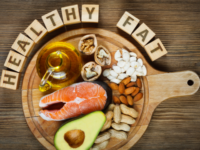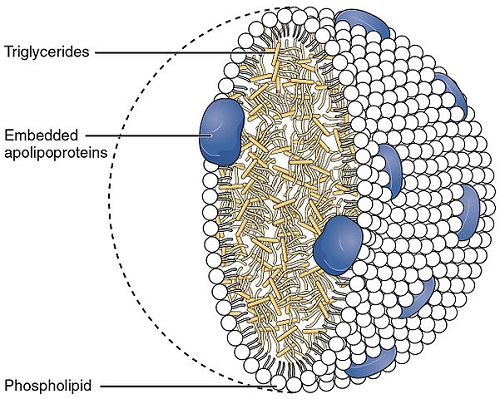Trans fat and saturated fats are both types of dietary fats that have some similarities, but they also have important differences. Here are some similarities between trans fats and saturated fats:
- Chemical Structure:
- Both trans fats and saturated fats are classified as “saturated fats” based on their chemical structure.
- Saturated fats have no double bonds between carbon atoms in their fatty acid chains, making them “saturated” with hydrogen atoms.
- Trans fats also have a similar saturated structure in terms of carbon-carbon bonds, but with at least one double bond in the trans configuration.
- Solid at Room Temperature:
- Both trans fats and many saturated fats are typically solid at room temperature.
- Examples of saturated fats that are solid at room temperature include butter, lard, and certain tropical oils.
- Dietary Sources:
- Both types of fats can be found in various food sources, including animal products and certain processed foods.
- Saturated fats are commonly found in meat, dairy products, and some plant-based oils.
- Trans fats are often present in partially hydrogenated oils, which are used in some processed and fried foods.
- Impact on Cholesterol Levels:
- Both trans fats and saturated fats can contribute to an increase in LDL (low-density lipoprotein) cholesterol levels, commonly known as “bad” cholesterol.
- Elevated levels of LDL cholesterol are associated with an increased risk of cardiovascular diseases.
Despite these similarities, it’s crucial to note the significant differences between trans fats and saturated fats, particularly in terms of their health effects. Saturated fats are generally considered less harmful than trans fats. Trans fats have been associated with a higher risk of heart disease, and their consumption has been widely discouraged. Many health organizations recommend limiting the intake of both trans fats and saturated fats for overall cardiovascular health. It’s essential to focus on healthier fat sources, such as unsaturated fats found in nuts, seeds, avocados, and olive oil, to promote heart health.

What is trans fats?
Trans fats, or trans fatty acids, are a type of unsaturated fat with at least one double bond in the trans configuration. Here are key characteristics of trans fats:
- Chemical Structure:
- Trans fats have a specific arrangement of carbon atoms with at least one double bond in the trans configuration. In this configuration, hydrogen atoms are located on opposite sides of the double bond.
- Sources:
- Trans fats can occur naturally in small amounts in some animal products, such as meat and dairy. However, the primary source of trans fats in the modern diet is through the industrial process of partial hydrogenation of vegetable oils.
- Industrial Production:
- Partial hydrogenation is a process where hydrogen is added to liquid vegetable oils to make them more solid at room temperature. This process increases the shelf life and stability of the oil for use in various food products.
- Food Applications:
- Trans fats have been commonly used in the food industry for frying and in the production of processed and packaged foods such as baked goods, margarine, and snacks.
- Health Implications:
- Consumption of trans fats has been linked to an increased risk of cardiovascular diseases. Trans fats raise LDL (low-density lipoprotein) cholesterol levels while simultaneously lowering HDL (high-density lipoprotein) cholesterol levels, contributing to an unfavorable blood lipid profile.
- Regulatory Actions:
- Due to health concerns associated with trans fats, many countries and regions have implemented regulations and policies to limit their use in food production. Some places have even banned the use of trans fats in certain food products.
- Labeling:
- In several countries, food regulations require the labeling of trans fat content on packaged foods, enabling consumers to make informed choices about their dietary intake.
- Shift in Food Industry Practices:
- In response to health concerns and regulatory changes, the food industry has gradually shifted away from the use of trans fats. Many manufacturers have reformulated their products to eliminate or reduce trans fat content.
It’s important for individuals to be aware of trans fats in their diet and make choices that prioritize healthier fat sources, such as unsaturated fats found in nuts, seeds, avocados, and olive oil, to promote overall cardiovascular health.
What is saturated fats?
Saturated fats are a type of dietary fat in which the fatty acid chains lack double bonds between the individual carbon atoms. Here are key characteristics of saturated fats:
- Chemical Structure:
- Saturated fats have a fully saturated carbon chain, meaning that each carbon atom in the fatty acid chain is bonded to as many hydrogen atoms as possible. There are no double bonds between carbon atoms.
- Physical State:
- Saturated fats are typically solid at room temperature. Examples include butter, lard, and certain tropical oils like coconut oil and palm oil.
- Dietary Sources:
- Saturated fats are found in various animal products, such as meat, poultry, dairy products (whole milk, cheese, butter), and eggs. Some plant-based sources, like coconut oil and palm oil, are also high in saturated fats.
- Health Implications:
- High intake of saturated fats has been associated with an increase in LDL (low-density lipoprotein) cholesterol levels, often referred to as “bad” cholesterol. Elevated levels of LDL cholesterol are considered a risk factor for cardiovascular diseases.
- Moderation:
- While saturated fats are an essential part of a balanced diet, health experts recommend consuming them in moderation. It’s advised to limit the intake of saturated fats to reduce the risk of heart disease.
- Dietary Guidelines:
- Many dietary guidelines and health organizations, including the American Heart Association and the World Health Organization, recommend that saturated fat intake should be limited to a certain percentage of total daily caloric intake.
- Food Industry Practices:
- The food industry has responded to health recommendations by reformulating products to reduce saturated fat content. Many processed foods now have reduced levels of saturated fats compared to previous formulations.
- Relation to Cardiovascular Health:
- A diet high in saturated fats has been linked to an increased risk of cardiovascular diseases, including coronary artery disease. However, recent research suggests that the relationship between saturated fats and heart health may be more complex and influenced by various factors.
It’s essential to maintain a balanced diet that includes a variety of fats, with an emphasis on healthier options such as unsaturated fats (monounsaturated and polyunsaturated fats) found in olive oil, avocados, nuts, and seeds.

What are the difference between Trans Fat and Saturated Fat?
Trans fats and saturated fats are both types of dietary fats, but they differ in their chemical structure, sources, and health implications. Here are the key differences between trans fats and saturated fats:
- Chemical Structure:
- Trans Fats: Have at least one double bond in the trans configuration, where hydrogen atoms are on opposite sides of the carbon-carbon double bond.
- Saturated Fats: Lack double bonds in their fatty acid chains, meaning that all available carbon atoms are saturated with hydrogen atoms.
- Sources:
- Trans Fats: Primarily come from industrial processes like partial hydrogenation of vegetable oils. Small amounts can also occur naturally in some animal products.
- Saturated Fats: Found in various animal products such as meat, poultry, dairy products (butter, cheese), and some plant-based oils (coconut oil, palm oil).
- Physical State:
- Trans Fats: Can be found in both liquid and solid forms depending on their composition.
- Saturated Fats: Typically solid at room temperature. Examples include butter, lard, and certain tropical oils.
- Health Effects:
- Trans Fats: Associated with an increased risk of cardiovascular diseases. They raise LDL (low-density lipoprotein) cholesterol levels while lowering HDL (high-density lipoprotein) cholesterol levels.
- Saturated Fats: High intake is linked to increased LDL cholesterol levels. While the relationship between saturated fats and heart health is debated, moderation is generally advised.
- Natural Occurrence:
- Trans Fats: Can occur naturally in small amounts in some animal products, but most are industrially produced.
- Saturated Fats: Found in both animal and plant sources, and some saturated fats are essential for certain bodily functions.
- Regulations and Recommendations:
- Trans Fats: Many countries have implemented regulations to limit or ban the use of artificial trans fats in food products due to health concerns.
- Saturated Fats: Dietary guidelines often recommend limiting saturated fat intake, but there are no widespread bans on naturally occurring saturated fats.
- Food Industry Practices:
- Trans Fats: There has been a significant reduction in the use of trans fats in the food industry due to health concerns.
- Saturated Fats: Some processed foods have been reformulated to reduce saturated fat content in response to health recommendations.
In summary, while both trans fats and saturated fats have been associated with adverse health effects, trans fats are largely considered more harmful, and there have been concerted efforts to reduce their presence in the food supply. Saturated fats, on the other hand, are still present in many foods, and recommendations emphasize moderation and choosing healthier fat sources.
Table summarizing the similarities and differences between Trans Fat and Saturated Fat
Here is a table summarizing the key similarities and differences between trans fats and saturated fats:
| Characteristic | Trans Fats | Saturated Fats |
|---|---|---|
| Chemical Structure | At least one double bond in trans configuration. | No double bonds; fully saturated carbon chains. |
| Sources | Industrially produced (partial hydrogenation). | Animal products and some plant-based oils. |
| Physical State | Can be liquid or solid, depending on composition. | Typically solid at room temperature. |
| Health Effects | Increases LDL cholesterol; decreases HDL cholesterol. | Increases LDL cholesterol; impact debated. |
| Natural Occurrence | Can occur naturally in small amounts in some foods. | Found in both animal and plant sources. |
| Regulations | Many countries have banned or restricted trans fats. | Dietary guidelines recommend limiting intake. |
| Food Industry Practices | Significant reduction in use due to health concerns. | Some reformulation to reduce saturated fat content. |
| Dietary Recommendations | Limit intake due to associated health risks. | Limit intake for heart health, but in moderation. |
Summary of Similarities Between Trans Fat and Saturated Fat
Here’s a summary of the similarities between trans fats and saturated fats:
- Saturated Structure:
- Both trans fats and saturated fats have a saturated structure in terms of carbon-carbon bonds. Saturated fats have no double bonds, while trans fats have at least one double bond in the trans configuration.
- Solid at Room Temperature:
- Both types of fats are generally solid at room temperature. For example, saturated fats are commonly found in butter, lard, and certain tropical oils, and trans fats can also be present in solid form depending on their composition.
- Dietary Sources:
- Both trans fats and saturated fats can be found in various food sources, including animal products and some processed foods. Saturated fats are present in meat, dairy products, and certain plant-based oils, while trans fats are often found in partially hydrogenated oils used in processed and fried foods.
- Impact on Cholesterol Levels:
- Both types of fats can contribute to an increase in LDL (low-density lipoprotein) cholesterol levels, which is associated with an increased risk of cardiovascular diseases. Saturated fats and trans fats both have been linked to unfavorable changes in cholesterol profiles.
- Health Concerns:
- Excessive consumption of both trans fats and saturated fats has been associated with negative health outcomes, particularly an increased risk of heart disease. Both types of fats are often recommended to be limited in the diet for better cardiovascular health.
It’s important to note that while these similarities exist, there are also crucial differences between trans fats and saturated fats, especially in terms of their chemical structures, sources, and regulatory actions. While saturated fats are found naturally in many foods, trans fats are often the result of industrial processes and have been the focus of significant health concerns and regulatory interventions.
Here are some frequently asked questions (FAQs) related to trans fats and saturated fats
Certainly! Here are some frequently asked questions (FAQs) related to trans fats and saturated fats:
1. What are trans fats?
- Trans fats are a type of unsaturated fat with at least one double bond in the trans configuration. They can occur naturally in small amounts in some animal products, but most trans fats in the modern diet are industrially produced through partial hydrogenation of vegetable oils.
2. What are saturated fats?
- Saturated fats are a type of dietary fat in which the fatty acid chains lack double bonds between the individual carbon atoms. They are typically solid at room temperature and can be found in various animal products and certain plant-based oils.
3. Why are trans fats harmful?
- Trans fats are considered harmful because they raise LDL (low-density lipoprotein) cholesterol levels and lower HDL (high-density lipoprotein) cholesterol levels, leading to an increased risk of cardiovascular diseases.
4. What foods contain trans fats?
- Foods that often contain trans fats include partially hydrogenated oils, fried foods, certain baked goods, margarine, and some processed and packaged snacks. Checking food labels can help identify trans fat content.
5. Are all saturated fats unhealthy?
- While excessive intake of saturated fats has been linked to an increased risk of heart disease, some saturated fats are considered essential for certain bodily functions. The key is moderation and choosing healthier sources.
6. What are some sources of saturated fats?
- Saturated fats are found in various animal products such as meat, poultry, dairy products (butter, cheese), and eggs. Some plant-based sources, like coconut oil and palm oil, are also high in saturated fats.
7. Are trans fats banned in foods?
- In many countries, there are regulations limiting or banning the use of artificial trans fats in food products due to health concerns. Some places have implemented labeling requirements to inform consumers about trans fat content.
8. How can I reduce my intake of trans fats and saturated fats?
- To reduce intake, choose healthier cooking oils (such as olive oil), limit consumption of processed and fried foods, opt for lean protein sources, and include more fruits, vegetables, and whole grains in your diet.
9. What are the health implications of a diet high in saturated fats?
- A diet high in saturated fats has been associated with an increase in LDL cholesterol levels, which is a risk factor for cardiovascular diseases such as coronary artery disease.
10. Are there healthier alternatives to trans fats and saturated fats?
- Healthier fat alternatives include monounsaturated fats (found in olive oil, avocados, and nuts) and polyunsaturated fats (found in fatty fish, flaxseeds, and walnuts). These fats are generally considered beneficial for heart health when consumed in moderation.












Leave a Reply